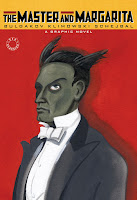So that is commendable, and interesting, and noteworthy.
Barbarella, Book 2: The Wrath of the Minute-Eater is still a Barbarella story: everything I mentioned about the first book is still here, to the same degree. It's very talky, and the talk is bafflegab most of the time. The world-building is a weird combination of overly baroque, quirkily uninformed, and entirely nonexistent. Characters are mostly ciphers who do things to make the plot advance another page or three - even Barbarella is, at best, a caricature mid-century "woman" subject to massive mood swings, from lust to anger to sadness, each one overwhelming at the time, in the standard pop-culture "Dames! What'ya gonna do?" laziness.
This time out, we begin with Barbarella as impresario of a circus - a sexy circus, in ways the narrative emphasizes but resolutely refuses to describe or show - in a milieu that seems to be just the solar system, though one filled with "worlds" (I assume habitats and terraformed moons, though I frankly doubt Forest thought that far). This is very different from the galactic scope of the first book's opening, but don't mind that, because a water-breathing man with a teleportation device has come to join the circus, for murky motives, and that will send the circus, for insufficient reasons, to "the obscure worlds," which "supposedly evolved in another space-time."
Like most of Barbarella, this is nonsense, but Forest commits to it: not just regular nonsense, but nonsense compounded and extended into a fantastic frothy edifice, by the time he's done.
Again, the bulk of the action takes place on one world: the spaceship Barbarella and her merry band of circus performers take to Spectra is important as both a method of travel and a plot token, but once they do the bafflegab aligning of time-streams and Barbarella is on Spectra, space-travel is off the menu for the rest of the book.
As in the first book, there are factions with silly names fighting over Maguffins with silly names and male leaders that Barbarella can fuck to get her way, as much as she wants anything in particular beside getting to fuck them. It probably all could make sense to the devoted mind, with enough study, several large sheets of graph paper, and gallons of strong coffee. But the point is that events happen, tables turn, Barbarella goes through all of her emotions (and the beds of most of the other main characters), and everything gets back to something like normal in the end.
Given the time-dilation effects, it should be several hundred years later in the normal universe at the end of the book, and there's a shrug in that direction, but who knows? As far as I can tell, this was the end of the Barbarella stories, and they stopped just as coherently as they began. (Which is: not a whole lot.)
Bottom line: there are very talky, confusing, goofy French comics, whose point was to be "sexy" in a way that will look quaint or pass unnoticed for most modern readers. Forest's art is dynamic and interesting; if you can see it large, and fight your way through the far-too-many captions covering it, that's probably the most intriguing aspect of Barbarella these days.




















